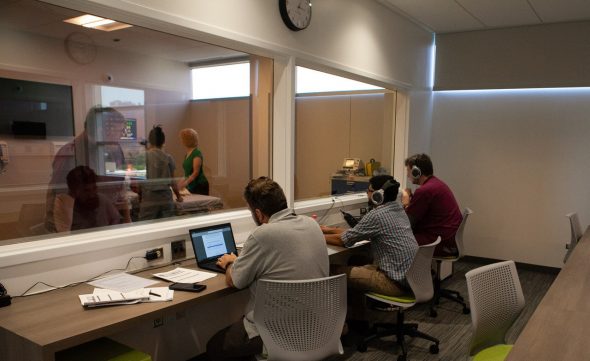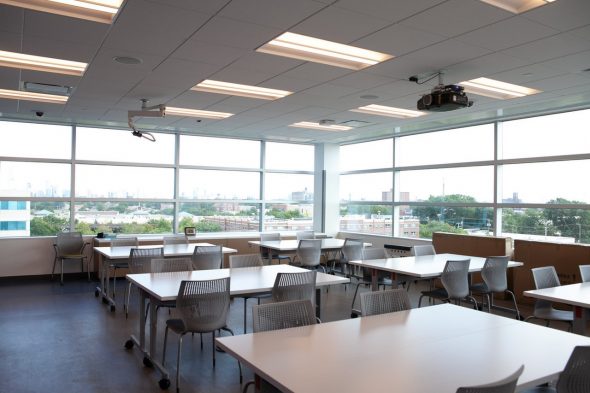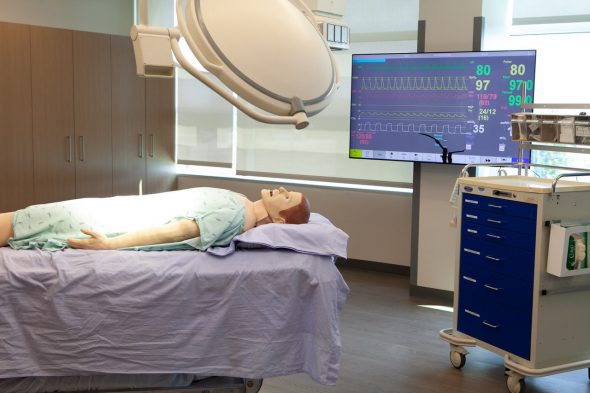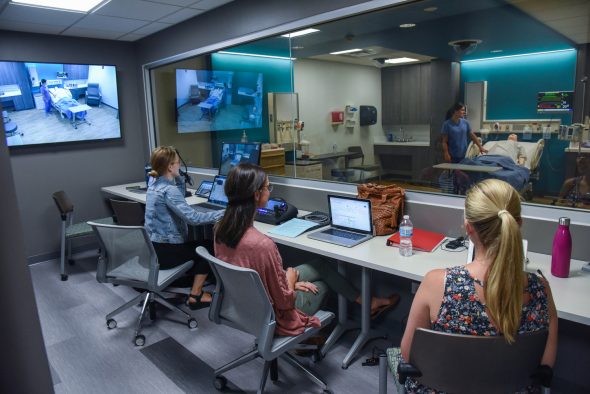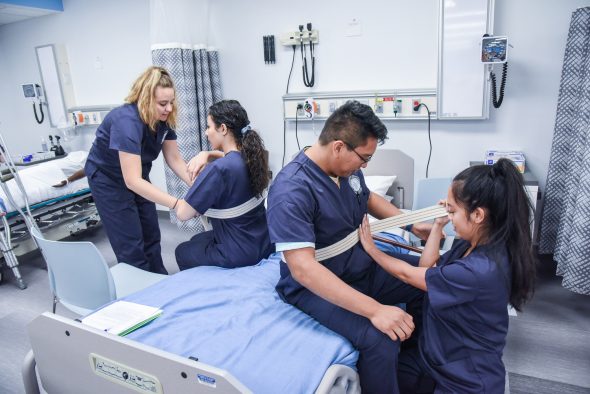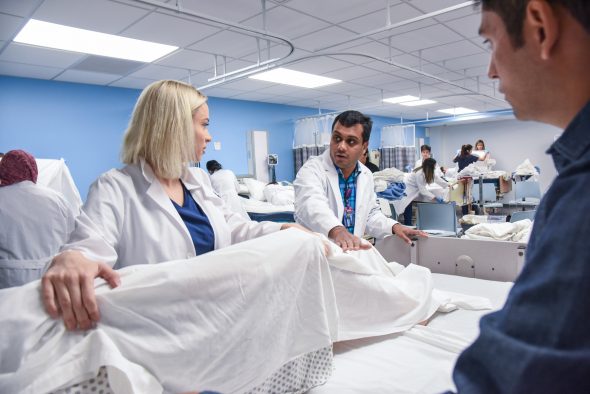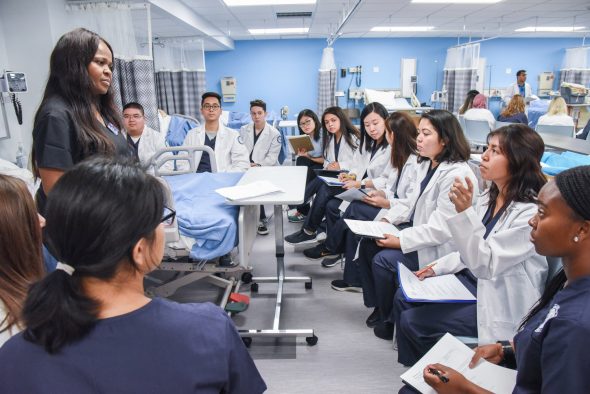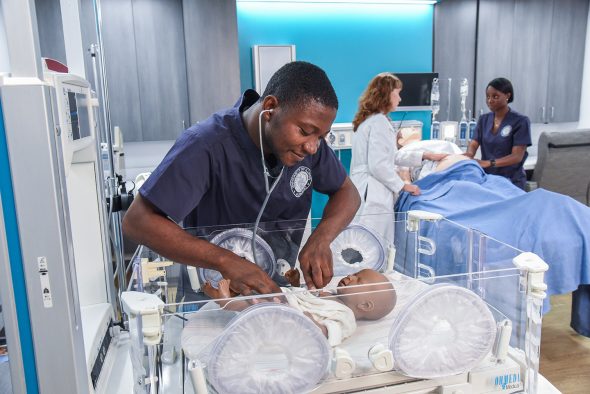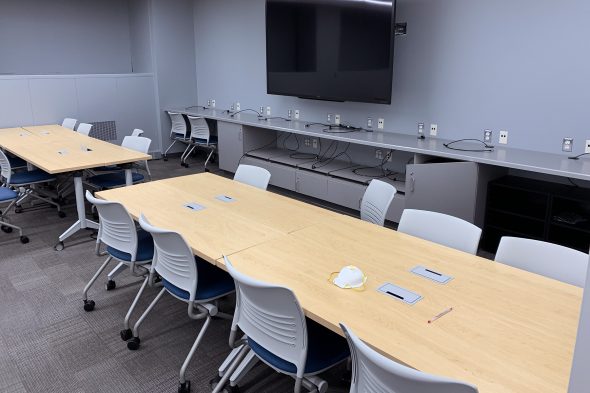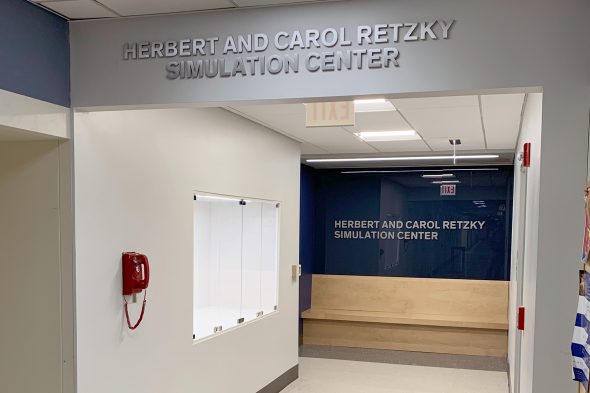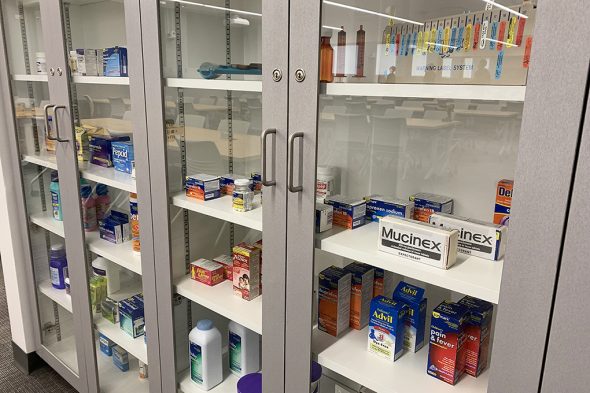UIC opens three new health care simulation centers
This fall, the University of Illinois at Chicago celebrates the opening of three health care simulation centers. The facilities, which are run individually by the university’s College of Medicine, College of Nursing and College of Pharmacy, use specially trained actors, advanced and computerized manikins of all ages, and simulated environments to help students and health care professionals practice clinical skills, communication and decision-making skills, and get hands-on training in medical diagnosis, treatment and care.
Together, these spaces will facilitate more than 50,000 hours of hands-on learning for nearly 20,000 learners working or pursuing careers in the health sciences.
The Simulation and Integrative Learning Institute
Part of the College of Medicine, the Simulation and Integrative Learning Institute is a $23.5 million, 28,000-square-foot center located at 1220 S. Wood St., on UIC’s campus in the Illinois Medical District. The institute and its new space is an upgrade from the college’s previous simulation space, the Graham Clinical Performance Center, which was only 8,000 square feet and operated beyond capacity for many years. In 2018, it provided more than 46,500 hours of training through 124 programs.
“Our expansion into this new space allows us to explore new and innovative projects and offer more training opportunities to learners at all levels, including patients and the community,” said UIC’s Dr. Christine Park, director of simulation and professor of anesthesiology at the College of Medicine. “What makes us special is that we provide integrative learning for the comprehensive development of clinicians. Simulation is not only about clinical and technical acumen, it is also about championing health equity, ethics and justice. Using simulation, we can promote compassion, human-centered and patient-partnered care, and even self-care and wellness.”
The new institute has 22 outpatient exam rooms where learners interact with standardized patients — specially trained actors — and practice skills such as diagnostic reasoning, patient examination and communication. The encounters provide increasing levels of difficulty, from a straightforward clinic visit to delivering devastating news. A special pod of clinical exam rooms is named the Dr. Allan L. and Mary L. Graham Clinical Performance Center, in honor of the Graham family’s longtime support of simulated learning at the college and its former simulation space.
Six inpatient rooms and a nurses’ station, similar to those seen in an intensive care unit or emergency room, and an operating room are also a highlight of the institute, which has 10 full-body, life-sized manikins. Based on direction from a control room, these manikins can experience a wide range of medical conditions, including heart failure and labor and delivery. The institute will also use virtual reality technology. One of the tools, Immersive Touch — which was developed at UIC — allows surgeons to develop their skills through simulation-based surgery.
“Our state-of-the-art facility looks like a modern hospital, and that’s the point,” Park said. “It allows us to leverage more complex simulated events than ever before. Full interprofessional teams can train in — hopefully rare, but incredibly high-risk — events such as mass casualties.”
A ribbon-cutting ceremony on Sept. 19 will celebrate the institute, which officially opened on Aug. 26.
M. Christine Schwartz Experiential Learning and Simulation Laboratory
Launched by a $5 million donation from the
“We use simulation to enhance classroom lectures and prepare all levels of nursing students for clinical rotations in hospitals, clinics and home care settings,” said Sue Kilroy, director of the Clinical Learning Resource Center at the College of Nursing. “Our new space, most importantly, allows us to follow the patient through various inpatient, outpatient and home care environments, and provides a safe space for learning skills that improve patients’ health and health care outcomes.”
A particular highlight is the Nita & Phil Francis Family Birthing Suite, named with an additional $1 million gift from the Francis family. The space will enable students to develop their clinical skills related to labor and delivery with the use of high-tech, high-fidelity manikins, including a female that can simulate childbirth.
Another unique feature is the home care setting — a model apartment —where students will learn how to care for patients throughout the lifespan in home environments. Students will practice nursing skills such as administering medications, cleaning and dressing wounds, examining the safety of the home environment, and instructing patients and their families on the patients’ plan of care.
“Debriefing with peers and faculty is a key part of the learning process that allows students to reflect on their actions, ask questions and receive constructive feedback that will not only make them more competent, but more confident and compassionate,” Kilroy said.
In addition, there are inpatient hospital rooms, an ER setting and a team-based learning classroom. There are also specific nurse practitioner rooms, including five NP exam rooms and one mental health NP room. The facility is further equipped with a lactation room, meditation room and student lounge.
The lab — which is 100% philanthropically funded — opened on Aug. 26 to students. The college will hold a ribbon-cutting ceremony on Oct. 12 to celebrate the Schwartz Lab, located at 845 S. Damen Ave. in the College of Nursing.
The Herbert and Carol Retzky Simulation Center
The UIC College of Pharmacy opened the Herbert and Carol Retzky Simulation Center on Aug. 26. The center, which was renovated with $1 million in funding from the Retzkys and is now named in their honor, features a simulated pharmacy and counseling rooms developed to simulate every step a pharmacist takes, from prescription entry to fulfillment.
The 5,000-
“From practicing filling and dispensing medication to counseling patients, these simulated learning opportunities help our students gain skills and confidence that will enable their success during practical rotations and as future pharmacists,” said Marlowe Djuric Kachlic, clinical assistant professor of pharmacy practice in the College of Pharmacy. “In addition to the use of standardized patients, we have incorporated education-based dispensing and electronic health record software into our simulations to make them as real-life as possible.”
Six courses at the college will rely on simulated learning experiences. In total, the college will provide more than 21,000 hours of simulation-based learning to its students, which will include leveraging standardized patients from the Simulation and Integrative Learning Institute at the College of Medicine.
A ribbon-cutting ceremony on Oct. 10 will celebrate the renovations and the new features of the lab, which is located at 833 S. Wood St. in the College of Pharmacy.
In addition to these three new spaces, UIC provides additional simulated learning opportunities to students. In the College of Dentistry, simulation accounts for more than 1,000 learning hours for nearly 200 students each year. The Cless Family Ophthalmologic Training and Simulation Center uses high-tech plastic eyes that sense tools and project a 3D image back to trainees through surgical microscopes. The OB/GYN Women of Steel Simulation Lab seeks to improve outcomes for pregnancies and neonates through simulation-based education. The Robotic Surgical Training Laboratory, which is currently undergoing its own renovation, helps medical students develop basic skills in robotic surgery and provides opportunities for physicians to develop skills in advanced applications of the robotic system.
Media are welcome inside the simulation centers. Tours or observation of faculty and students participating in simulated-learning activities will provide an opportunity for photos, video and interviews with faculty and students. Media wishing to cover the simulation centers should contact Jackie Carey, at jmcarey@uic.edu or (312) 996-8277, or Jeffron Boynes, at jboynes@uic.edu or (773) 633-7971.
